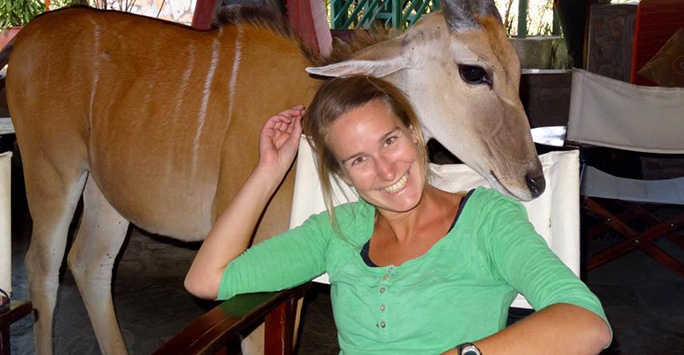
Research interests
My main research interests lie in the field of behavioural ecology, in particular how the physical and and social environment shapes animal communities. Behavioural adaptations and life history decision in response to changes in the environment can have long-lasting effects on the population level. Understanding the underlying processes is important to predict how individuals may react, e.g. in response to climate change or human disturbances.
In collaboration with Jakob Bro-Jorgensen (University of Liverpool) and Dan Franks (University of York), I am currently investigating what drives the formation of mixed species groups, focusing in particular on the role of information transfer between species. To address this question, we focus on the 12 most common species of large herbivores found on the African Savannah. With our research we aim to deepen the general understanding of processes in community ecology, thereby providing information for conservation management.
Education and career
- Diploma in Biology (2002-2008), University of Bielefeld/German Primate Centre
- Research Assistant (2008-2009), Galapagos Sea Lion Project, University of Bielefeld
- PhD student (2010-2014), Galapagos Sea Lion Project, University of Bielefeld
- Field assistant (2014), Hawaiian Monk Seal Project, JIMAR/NOAA
- Postdoctoral researcher (2014-2015), Career Bridge Stipend, University of Bielefeld
- Postdoctoral researcher (since 2015), Masai Mara Herbivore Project, University of Liverpool
Publications
Trillmich F, Meise K, Kalberer S, Mueller B, Piedrahita P, Pörschmann U, Wolf JBW, Krueger O (2016). On the challenge of interpreting census data: Insights from a study of an endangered pinniped. PloS one 11: e0154588
Meise K, von Engelhardt N, Forcada J, Hoffman JI (2016). Offspring hormones reflect the maternal prenatal environment: Potential for foetal programming? PloS one 11: e0145352
Meise K, Garcia-Parra C (2015). Correlates and consequences of Philophthalmus zalophi infections on juvenile Galapagos sea lions (Zalophus wollebaeki). Marine Biology.
Meise K, Müller B, Zein B, Trillmich F (2014). Applicability of single-camera photogrammetry to determine body dimensions of pinnipeds: Galapagos sea lions as an example. Plos One 9: e101197.
Piedrahita P, Meise K, Werner C, Krüger O, Trillmich F (2014). Lazy sons and self-sufficient daughters: are sons more demanding? Animal Behaviour 98: 69-78.
Meise K, Piedrahita P, Krüger O, Trillmich F (2014). Being on time: size-dependent attendance patterns affect male reproductive success. Animal Behaviour 93: 77-86.
Meise K, Krüger O, Piedrahita P, Trillmich F (2013). Site fidelity in male Galápagos sea lions: a lifetime perspective. Behavioural Ecology and Sociobiology 67: 1001-1011.
Meise K, Krüger O, Piedrahita P, Müller A, Trillmich F (2013). Proximity loggers on amphibious mammals: a new method to study social relations in their terrestrial habitat. Aquatic Biology 18: 81-89.
Kraus C, Müller B, Meise K, Piedrahita P, Pörschmann U, Trillmich F (2013). Mama’s boy: sex differences in juvenile survival in a highly dimorphic large mammal, the Galapagos sea lion. Oecologia 171: 893-903.
Meise K, Fischer J, Keller C, Cowlishaw G (2011). Sources of acoustic variation: implications for production specificity and call categorization in chacma baboon grunts. Journal of the Acoustical Society of America 129: 1631-1641.
Back to: Mammalian Behaviour and Evolution